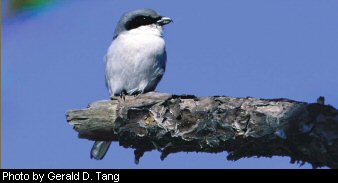

|
Wildlife Diversity Notebook: The Loggerhead Shrike
Scientific Name: Lanius ludovicianus (LANE- ih -us lewd-oh-VICK- ih -ANE-us) Status: Considered a “Species of Concern” by the U. S. Fish and Wildlife Service. West Virginia Status: Loggerhead shrikes are found in the Eastern Panhandle and southeastern regions of West Virginia. The species seems to be declining in West Virginia. Description: With a length of 8 to 10 inches, the adult loggerhead shrike is about the size of a robin. Shrikes are gray above and lighter in the breast and abdomen; their wings and tails are predominantly black with white patches which are conspicuous in flight. Males and females are similar in appearance. Shrikes can be distinguished from the similarly colored mockingbird by their black eyes (mockingbirds have yellow eyes), stout heads, heavy beaks with hooked tips (as seen in birds of prey), and black facial masks. Young shrikes resemble adults although they have slightly darker, barred undersides and buff-colored wing patches. Habitat: Shrikes are birds of pastures and abandoned agricultural areas. They prefer areas with short vegetation interspersed with scattered trees, shrubs, utility poles, fence posts and hedgerows for perching. These are often areas that are grazed. Shrikes nest in small trees, preferring hawthorns and red cedars, and multiflora rose. They usually place their nest between 4 to 12 feet (1.2 and 3.7 meters ) above the ground. The second nest of the season may be placed in a higher location, often in a tall tree. Areas with intensive row cropping, which makes spotting and capturing prey difficult, are not well suited to shrikes. The wintering habitat of the shrike does not differ appreciably from its breeding habitat. When weather conditions become adverse, however, shrikes sometimes move to shrubby or forested areas that offer greater protection from the elements. Threats And Prospects: The cause or causes of the 87 percent decline noted in the population of loggerhead shrikes in the Northeast was thought to be due to loss of habitat as farms and pastures were abandoned and became thickets and young forests. However, large expanses of apparently suitable habitat exist in the Northeast where shrikes are absent. It has been proposed that the accumulation of agricultural pesticides in the food chain might have affected the reproductive success of these predaceous birds, but judging from the healthy condition of most broods, pesticide poisoning does not appear to be a major factor limiting shrike populations. Because shrikes often use roadsides for perching and hunting, they may be suffering an elevated rate of mortality due to collisions with motor vehicles. It has also been suggested that because shrikes seem to be reproducing successfully, pressures in their wintering range may be causing population declines. At this time there is little information on where the loggerhead shrikes that breed in West Virginia spend the winter, but at least some birds appear to stay near their breeding territories. Habitat fragmentation in both the wintering and summer range of the loggerhead shrike cannot be ignored as a possible factor in the decline of this bird's eastern populations. Range: The breeding range of the loggerhead shrike once comprised much of North America, spanning from southern Canada to Mexico. Wintering shrike populations commonly occur throughout the southern half of the United States, extending into West Virginia. Thus, West Virginia is both within the breeding and wintering range of the loggerhead shrike. Currently, this bird is much more restricted in its breeding range. It has apparently been extirpated (eliminated from a local area) as a breeder north of Pennsylvania, except for a band of several counties in northern New York and Vermont. In West Virginia, there have been recent reports of confirmed or suspected breeding from Berkeley, Grant, Greenbrier , Hardy, Jefferson, Monroe, Pocahontas and Randolph counties. Life History: In West Virginia, shrikes return to their breeding territories in early April. The male initiates a courtship ritual which includes singing and flashing its tail. Both the male and the female take part in building a nest out of twigs. The nest is lined with grasses and down feathers. Four to six eggs are typically laid in April and incubated for 16 to 18 days. During incubation, it is the male's role to hunt and feed the female while she tends to the eggs. Once hatched, the fledglings remain in the nest for approximately three weeks, after which they depart and begin to learn foraging skills. After two to three months of training, during which the male leads the juveniles to prey items, the young birds stake out their own territories. The pair may rear a second brood of young later in the summer. In October, shrikes begin migrating south. Most populations winter in the southern United States, with some having been observed in southwestern and eastern West Virginia. Diet: Unlike most passerines (perching birds), shrikes are predaceous. They hunt and kill their prey. Shrikes eat a variety of small animals including grasshoppers, crickets, beetles, mice, voles, shrews, birds, snakes, frogs and worms. In summer, insects comprise the bulk of the shrike's diet, while in the winter shrikes rely more on small mammals. Shrikes hunt from perches in trees or on fence posts where they scan the ground for prey items. Tall grass and thick brush make it difficult for shrikes to search for food. Thus, where fields have become overgrown, shrikes tend to be rare or absent. Shrikes are sometimes known as “butcher birds” because of their habit of impaling prey on thorns or barbed wire. This is a necessary behavior because, unlike raptors (birds of prey), shrikes have weak feet, and are unable to grip carcasses while eating them. Impaled food items may also serve to mark a bird's territory. |
 Common Name: Loggerhead Shrike
Common Name: Loggerhead Shrike